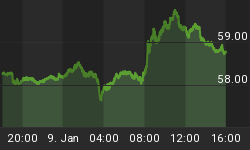Investor sentiment has turned bearish as investors are moving money to the sidelines.
Investor Sentiment Composite Indicator
Figure 1 is a weekly chart of the NASDAQ with the Investor Sentiment Composite Indicator in the lower panel. This indicator measures the opinions of four different segments of the investing public. The Investors Intelligence poll seeks market opinion from newsletter writers. The American Association of Individual Investors polls individual investors. The Market Vane Bulls polls investment advisors and the put-call ratio attempts to quantify the behavior of option players. Statistically significant extremes in the data are sought and combined into one single indicator.
Figure 1. Investor Sentiment Composite Indicator
The current indicator value is at an extreme bearish reading, and in general, this is a bullish signal.
A Dynamic Investing Environment
First, I am going to show you why this is such a potentially dynamic investing environment. Then I will show you what I think is the safest and best way to navigate this environment because the potential to get hurt real bad is ever present.
The first study will buy the NASDAQ market when the Investor Sentiment Composite Indicator reaches a bearish extreme (i.e., bullish signal) and then we will exit the trade when the bearish extreme is relieved. In other words, looking at figure 1, we will only be in the market when the indicator is below the red line.
In 16.5 years, there were 33 instances (or trades) when the indicator dipped into the extreme. 73% of your trades would have been winners with the average winner twice the average loser. This strategy generated 1829 NASDAQ points; a buy and hold strategy over the same time frame generated 2000 NASDAQ points. With this strategy you were only in the market 18% of the time, and your largest equity curve drawdown was 37%.
Ok now think about this: this strategy almost beat buy and hold with only 18% market exposure, and with one half the drawdown. That is incredible. In other words, in this type of market environment gains can be made that are over 100% annualized. Now that is dynamic!
Risks
That is the wow part of this presentation. Now for the sobering part, and that is risk. To understand the risk involved here look at the Maximum Adverse Excursion graph in figure 2. The MAE graph shows every trade from this strategy. Winning trades are noted with the green carets and the red carets are the losing trades.
Figure 2. MAE Graph
So what does the MAE measure? If you are like most traders, you put on a trade, and then you watch that position move adverse to your entry point as very few individuals always pick the bottom tick. MAE is how much in percentage terms the trade loses before it turns around to become a winner or is closed out as a loser.
For example, the trade in the MAE graph with the blue box around it had a MAE of 11% (x- axis); this trade did recover, but it was closed out for a 6% loss (y- axis). We know it was a loser because it is a red caret.
Out of the 33 trades, there were 8 that had MAE's greater than 10%. 4 of the trades had MAE's greater than 20%. Can you trade a strategy that has the possibility where you suffer a drawdown greater than 20%? I can't. Yes, two out of the 4 mega drawdown trades did recover, but once again, ask yourself could you have sat through such pain.
A Better Way
Sentiment is an early signal, and the data clearly supports this idea.
Instead of buying the market when the indicator first turns extreme, we will wait 2 weeks and then buy. As in the above example, I will exit when the extreme in bearish sentiment is relieved (i.e., the indicator turns blue).
By waiting 2 weeks, our 33 trades now yield 2591 NASDAQ points. This is much better than buy and hold, and 40% better than the first strategy. 70% of your trades were winners, and your equity curve draw down was reduced to 21%. Your total time in the market was 13%.
The MAE graph is shown in figure 3, and the number of trades with MAE's greater
Figure 3. MAE Graph
than 10% has been reduced from 8 to 5. But interestingly, by waiting 2 weeks, 27 of the 33 trades have MAE's less than 5%.
This is clearly a case of less being more!!!
As of March 12, 2007, investor sentiment, as I have measured it, has turned bearish, and this is a bullish signal. The data suggests that sentiment turns early and that the best period of buying is about 2 weeks after the signal. Adding price and breadth confirmation to this analysis may improve the results.
period of buying is about 2 weeks after the signal. Adding price and breadth confirmation to this analysis may improve the results.
Recent articles written by Guy M. Lerner:
"The Three Phases of a Rally" - 11/29/06
"Semi's Signal Weakness Ahead" - 12/13/06
"Charts Skew Bearish for 2007" - 12/27/06"Is This Time Different?" - 1/9/07
"Divergences Don't Follow Popular Theory" - 1/10/07
"Positioned for a Bearish Outcome" - 1/31/07
"Bulls Have Limited Buying Power at Present" - 1/31/07
"Moving to a Bearish Market Bias" - 2/13/07
"Bearish Charts from Emerging Markets" - 2/13/07
"A Can't Miss Market" - 2/16/07
"No Safety in Safe Stocks" - 2/21/07
"Does Surge in Semi's Signal a Top?" - 2/23/07
"My Two Favorite Housing Shorts: Lennar and Meritage Homes" - 2/23/07















